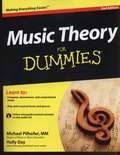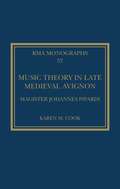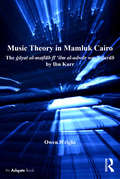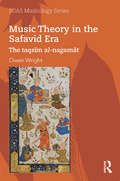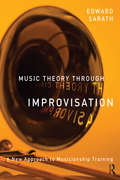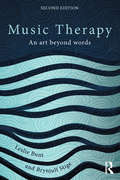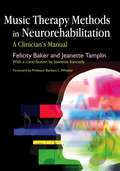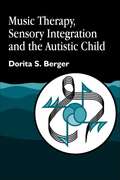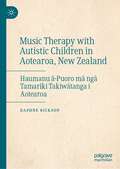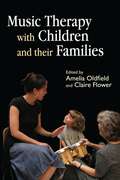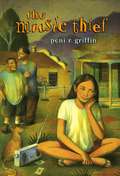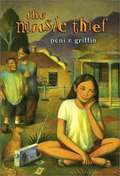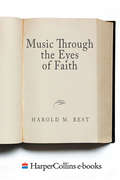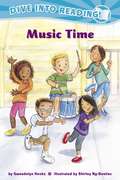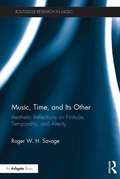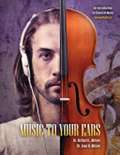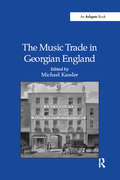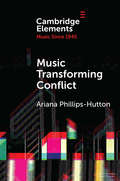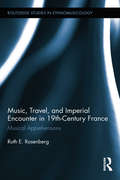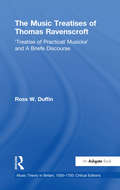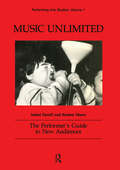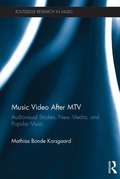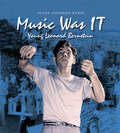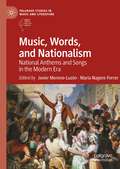- Table View
- List View
Music Theory For Dummies (Second Edition)
by Michael Pilhofer Holly DayGrasp the concepts needed to compose, deconstruct, and comprehend music. Whether you're a student of music or a music lover, "Music Theory For Dummies" presents you with essential information on how to read, write, and understand music, as well as helpful hints on composing, arranging, and creating original melodies, harmonies, and chords. "Music Theory For Dummies" gives you a friendly, unintimidating overview of the material covered in a typical college-level course and makes music theory easy to understand. It includes updated information on current teaching techniques; the newest music examples and genres; information on mastering major and minor scales, using intervals, and recognizing pitches and clefs; the lowdown on rhythms, tempo, dynamics, and navigation; how to transcribe the music you hear and transposing it to other keys; harmonizing and accompanying melodies; composing and arranging for voices and instruments; performing your own music; and much more.
Music Theory in Late Medieval Avignon: Magister Johannes Pipardi (Royal Musical Association Monographs)
by Karen M. CookThe manuscript Seville, Biblioteca Colombina y Capitular 5-2-25, a composite of dozens of theoretical treatises, is one of the primary witnesses to late medieval music theory. Its numerous copies of significant texts have been the focus of substantial scholarly attention to date, but the shorter, unattributed, or fragmentary works have not yet received the same scrutiny. In this monograph, Cook demonstrates that a small group of such works, linked to the otherwise unknown Magister Johannes Pipudi, is in fact much more noteworthy than previous scholarship has observed. The not one but two copies of De arte cantus are in fact one of the earliest known sources for the Libellus cantus mensurabilis, purportedly by Jean des Murs and the most widely copied music theory treatise of its day, while Regulae contrapunctus, Nota quod novem sunt species contrapunctus, and a concluding set of notes in Catalan are early witnesses to the popular Ars contrapuncti treatises also attributed to des Murs. Disclosing newly discovered biographical information, it is revealed that Pipudi is most likely one Johannes Pipardi, familiar to Cardinal Jean de Blauzac, Vicar-General of Avignon. Cook provides the first biographical assessment for him and shows that late fourteenth-century Avignon was a plausible chronological and geographical milieu for the Seville treatises, hinting provocatively at a possible route of transmission for the Libellus from Paris to Italy. The monograph concludes with new transcriptions and the first English translations of the treatises.
Music Theory in Mamluk Cairo: The ġāyat al-maṭlūb fī ‘ilm al-adwār wa-’l-ḍurūb by Ibn Kurr (SOAS Studies in Music)
by Owen WrightThe ġāyat al-maṭlūb fī ‘ilm al-adwār wa-'l-ḍurūb by Ibn Kurr is the only theoretical text of any substance that can be considered representative of musicological discourse in Cairo during the first half of the fourteenth century CE. Indeed, nothing comparable survives from the whole Mamluk period, which extends from 1260 until the Ottoman invasion and conquest of Egypt in 1516. But its value does not derive merely from its fortuitous isolation: it is important, rather, because of the richness of the information it provides with regard to modal and rhythmic structures, and also because of the extent to which the definitions it offers differ from those set forth in an interrelated series of major theoretical works in both Arabic and Persian that span the period from the middle of the thirteenth century to the late fifteenth. Alongside the presumption of transregional uniformity these texts suggest, it consequently asserts the significance of local particularism. Owen Wright provides a critical edition of the text itself, together with a glossary, prefaced by an introduction and a detailed commentary and analysis. The introduction provides immediate context, situating the work in relation to the dominant theoretical tradition of the period and providing biographical information about the author, active in Cairo during the first half of the fourteenth century.
Music Theory in the Safavid Era: The taqsīm al-naġamāt (SOAS Musicology Series)
by Owen WrightThe Safavid era (1501–1722) is one of the most important in the history of Persian culture, celebrated especially for its architecture and art, including miniature paintings that frequently represent singers and instrumentalists. Their presence reflects a sophisticated tradition of music making that was an integral part of court life, yet it is one that remains little known, for the musicological literature of the period is rather thin. <P><P>There is, however, a significant exception: the text presented and analysed here, a hitherto unpublished and anonymous theoretical work probably of the middle of the sixteenth century. With a Sufi background inspiring the use of the nay as a tool of theoretical demonstration, it is exceptional in presenting descriptive accounts of the modes then in use and suggesting how these might be arranged in complex sequences. As it also gives an account of the corpus of rhythmic cycles it provides a unique insight into the basic structures of art-music during the first century of Safavid rule.
Music Theory Through Improvisation: A New Approach to Musicianship Training
by Ed SarathDesigned for Music Theory courses, Music Theory Through Improvisation presents a unique approach to basic theory and musicianship training that examines the study of traditional theory through the art of improvisation. The book follows the same general progression of diatonic to non-diatonic harmony in conventional approaches, but integrates improvisation, composition, keyboard harmony, analysis, and rhythm. Conventional approaches to basic musicianship have largely been oriented toward study of common practice harmony from the Euroclassical tradition, with a heavy emphasis in four-part chorale writing. The author’s entirely new pathway places the study of harmony within improvisation and composition in stylistically diverse format, with jazz and popular music serving as important stylistic sources. Supplemental materials include a play-along audio in the downloadable resources for improvisation and a companion website with resources for students and instructors.
Music Therapy: An art beyond words (Ashgate Popular And Folk Music Ser.)
by Leslie Bunt Brynjulf StigeMusic therapy is recognised as being applicable to a wide range of healthcare and social contexts. Since the first edition of Music Therapy: An art beyond words, it has extended into areas of general medicine, mainstream education and community practice. This new edition revises the historical and theoretical perspectives and recognises the growing evidence and research base in contemporary music therapy. Leslie Bunt and Brynjulf Stige document the historical evolution of music therapy and place the practice within seven current perspectives: medical, behavioural, psychoanalytical, humanistic, transpersonal, culture-centred and music-centred. No single perspective, individual or group approach is privileged, although the focus on the use of sounds and music within therapeutic relationships remains central. Four chapters relate to areas of contemporary practice across different stages of the lifespan: child health, adolescent health, adult health and older adult health. All include case narratives and detailed examples underpinned by selected theoretical and research perspectives. The final two chapters of the book reflect on the evolution of the profession as a community resource and the emergence of music therapy as an academic discipline in its own right. A concise introduction to the current practice of music therapy around the world, Music Therapy: An art beyond words is an invaluable resource for professionals in music therapy and music education, those working in the psychological therapies, social work and other caring professions, and students at all levels.
Music Therapy Methods in Neurorehabilitation: A Clinician's Manual
by Barbara L Wheeler Jeanette Kennelly Felicity Baker Jeanette TamplinThe value of music therapy in neurological rehabilitation is increasingly recognised and this practical manual provides comprehensive guidance for clinicians on the application of music therapy methods in neurorehabilitation. Felicity Baker and Jeanette Tamplin combine research findings with their own clinical experience and present step-by-step instructions and guidelines on how to implement music therapy techniques for a range of therapeutic needs. Photographs clearly illustrate interventions for physical rehabilitation, for example through the use of musical instruments to encourage targeted movement. The chapter on cognitive rehabilitation includes resources and lists suitable songs for use in immediate memory or abstract thinking tasks, among others. In her chapter on paediatric patients, Jeanette Kennelly demonstrates how procedures can be adapted for working clinically with children. A comprehensive list of terminology commonly used in neurological rehabilitation is also included. Music Therapy Methods in Neurorehabilitation will prove an invaluable reference book for music therapy clinicians and students. It is also suitable for work with other populations, in particular for work in special education.
Music Therapy, Sensory Integration and the Autistic Child
by Dorita S. BergerMusic's ability to influence emotions and moods is universally acknowledged, and music therapists have long known that stimulating the brain through the auditory system is a key to obtaining remarkable responses. Music therapy is a particularly effective tool when working with children with autism spectrum conditions, because music communicates with these children on a level where mere words cannot go. Written in a way that is both informative for the professional and accessible for parents, this book furthers the already strong case for the use of music therapy as a resource to encourage behavioural changes for the better in children with autism spectrum conditions. Placing particular emphasis upon sensory integration, the author discusses contributing factors to the behaviour of people on the autism spectrum, and, through the use of case studies, presents the latest approaches in music therapy that are enabling children with autism spectrum conditions to better cope with sensory integration.
Music Therapy with Autistic Children in Aotearoa, New Zealand: Haumanu ā-Puoro mā ngā Tamariki Takiwātanga i Aotearoa
by Daphne RicksonIn this unique text, ten cases of music therapy with autistic children (tamariki takiwātanga) are critiqued through the eyes of family members and other autism experts. Rickson uses her wealth of experience to contextualise their rich observations in a thorough review of research and practice literature, to illustrate the ways music therapists engage autistic children in the music therapy process, highlight the various ways music therapy can support their health and well-being, and demonstrate how music therapy processes align with good practice as outlined in the New Zealand Autism Spectrum Disorder Guideline.
Music Therapy with Children and their Families
by Tiffany Hughes Emma Davies Vince Hesketh Rachel Bull Nicky O'Neill Joy Hasler Kay Sobey Sarah Russel Helen Loth Claire Flower Jassenka Horvat Colette Salkeld Amelia OldfieldIn the past, music therapy work with children typically took place in special schools without the family being present. More recently, music therapy has become a widespread practice, and this book reflects the variety of settings within which music therapists are now working with children together with their families. The contributors are music therapists with experience of working with children and their families in a range of different environments, such as schools, hospices, psychiatric units, child development centres and in the community. They describe their approaches to family work with client groups including children with autism, learning disabled toddlers, adopted children and looked after teenagers. Their experiences demonstrate that involving the family in a child's music therapy can be beneficial for everyone, and that it is possible to address relationship issues within the family as part of the treatment. This book will provide useful insight into the growing area of music therapy with children and their families, and will be valuable for music therapy professionals and students, as well as other medical and teaching professionals who work with families.
The Music Thief
by Peni R. GriffinIn a harsh and noisy time, a young girl's key to her dreams -- music -- may be closer than she thinks.There was a new song playing in the back of Alma's head. An angry song, for Jovita and her killer, and Eddie, and everybody whose family did things that everybody had to live with. She could feel it, thumping in her brain, but couldn't hear it well enough to even hum it. Not in this house.She needed quiet, and a guitar. She needed Mrs. B's house.Alma misses many things. She misses her grandmother; her big brother Eddie back when he didn't deal drugs; the freedom she had before her baby niece Silvita was born; and now, worst of all, she misses Jovita, the singer she idolized who was recently killed in a drive-by shooting. Just when things seem hopeless, Alma discovers the cat door in her neighbor's often-empty home, and an unintended window opens into a better world, full of music.And what could be the harm in Alma's stealing (borrowing, really) a little peace and quiet, maybe even a ticket to her future?Peni R. Griffin has created a character at once bitter and optimistic. She has succeeded, even more impressively, in making the "dark" world surrounding Alma shine with small -- but life-changing -- possibility.
The Music Thief
by Peni R. GriffinAlma misses many things. She misses her grandmother; her big brother Eddie back when he didn't deal drugs; the freedom she had before her baby niece Silvita was born; and now, worst of all, she misses Jovita, the singer she idolized who was recently killed in a drive-by shooting. Just when things seem hopeless, Alma discovers the cat door in her neighbors often-empty home, and an unexpected window opens into a better world, full of music. And what could be the harm in Alma's stealing (borrowing really) a little peace and quiet, maybe even a ticket to her future? Peni R. Griffin has written a stunning novel that is at once brutally honest and realistically hopeful. Alma's world shines with small but life-changing possibility.
Music Through the Eyes of Faith
by Harold Best"Christian musicians know of the obligation to make music as agents of God's grace. They make music graciously, whatever its kind or style, as ambassadors of Christ, showing love, humility, servanthood, meekness, victory, and good example . . . Music is freely made, by faith, as an act of worship, in direct response to the overflowing grace of God in Christ Jesus."Co-sponsored by the Christian College Coalition, this thought-provoking study of music-as-worship leads both students and experienced musicians to a better understanding of the connections between music making and Christian faith."Christian music makers have to risk new ways of praising God. Their faith must convince them that however strange a new offering may be, it cannot out-reach, out-imagine, or overwhelm God. God remains God, ready to swoop down in the most wonderful way, amidst all of the flurry and mystery of newness and repetition, to touch souls and hearts, all because faith has been exercised and Christ's ways have been imitated. Meanwhile, a thousand tongues will never be enough."Best relates musical practice to a larger theology of creation and creativity, and explores new concepts of musical quality and excellence, musical unity, and the incorporation of music from other cultures into today's music.
Music Time
by Gwendolyn Hooks Shirley Ng-BenitezHenry dreams of becoming a rock star drummer and practices at home whenever he can. One day while Henry is drumming, his mom has to work, and asks him to stop playing. Henry decides to go outside to play his drum and he sees his friends. Henry wants to keep practicing, but he also wants to play with his friends. By playing Freeze Dance, he can do both. And when his mother finishes work that evening, they figure out how to enjoy music together too.
Music, Time, and Its Other: Aesthetic Reflections on Finitude, Temporality, and Alterity (Routledge Research in Music)
by Roger W. SavageMusic, Time, and Its Other explores the relation between the enigmatic character of our temporal experiences and music’s affective power. By taking account of competing concepts of time, Savage explains how music refigures dimensions of our experiences through staking out the borderlines between time and eternity. He examines a range of musical expressions that reply to the deficiency born from the difference between time and an order that exceeds or surpasses it and reveals how affective tonalities of works by Bach, Carolan, Debussy, Schoenberg, Messiaen, and Glass augment our understanding of our temporal condition. Reflections on the moods and feelings to which music gives voice counterpoint philosophical investigations into the relation between music’s power to affect us and the force that the present has with respect to the initiatives we take. Music, Time, and Its Other thus sets out a new approach to music, aesthetics, politics, and the critical roles of judgment and imagination.
Music to Our Ears (Fountas & Pinnell LLI Purple #Level R)
by Jack SilbertText Elements <p> Genre: Expository <p> Text Structures <p> Main: Chronological Sequence <p> Embedded: Categorical, Compare/ Contrast, Cause/Effect <p> Text Features: table of contents, headings, sidebars, glossary
Music to Your Ears: An Introduction to Classical Music
by Richard L Mcgee Joan B McgeeMusic to Your Ears: An Introduction to Classical Music
The Music Trade in Georgian England: Musical Instruments And Printed Music
by Michael KasslerIn contrast to today's music industry, whose principal products are recorded songs sold to customers round the world, the music trade in Georgian England was based upon London firms that published and sold printed music and manufactured and sold instruments on which this music could be played. The destruction of business records and other primary sources has hampered investigation of this trade, but recent research into legal proceedings, apprenticeship registers, surviving correspondence and other archived documentation has enabled aspects of its workings to be reconstructed. The first part of the book deals with Longman & Broderip, arguably the foremost English music seller in the late eighteenth century, and the firm's two successors - Broderip & Wilkinson and Muzio Clementi's variously styled partnerships - who carried on after Longman & Broderip's assets were divided in 1798. The next part shows how a rival music seller, John Bland, and his successors, used textual and thematic catalogues to advertise their publications. This is followed by a comprehensive review of the development of musical copyright in this period, a report of efforts by a leading inventor, Charles 3rd Earl Stanhope, to transform the ways in which music was printed and recorded, and a study of Georg Jacob Vollweiler's endeavour to introduce music lithography into England. The book should appeal not only to music historians but also to readers interested in English business history, publishing history and legal history between 1714 and 1830.
Music Transforming Conflict (Elements in Music since 1945)
by Ariana Phillips-HuttonTeach the world to sing, and all will be in perfect harmony - or so the songs tell us. Music is widely believed to unify and bring peace, but the focus on music as a vehicle for fostering empathy and reconciliation between opposing groups threatens to overly simplify our narratives of how interpersonal conflict might be transformed. This Element offers a critique of empathy's ethical imperative of radical openness and positions the acknowledgement of moral responsibility as a fundamental component of music's capacity to transform conflict. Through case studies of music and conflict transformation in Australia and Canada, Music Transforming Conflict assesses the complementary roles of musically mediated empathy and guilt in post-conflict societies and argues that a consideration of musical and moral implication as part of studies on music and conflict offers a powerful tool for understanding music's potential to contribute to societal change.
Music, Travel, and Imperial Encounter in 19th-Century France: Musical Apprehensions (Routledge Studies in Ethnomusicology)
by Ruth RosenbergThis book considers the activities and writings of early song collectors and proto-ethnomusicologists, memoirists, and other "musical travelers" in 19th-century France. Each of the book’s discrete but interrelated chapters is devoted to a different geographic and discursive site of empire, examining French representations of musical encounters in North America, the Middle East, as well as in contested areas within the borders of metropolitan France. Rosenberg highlights intersections between an emergent ethnographie musicale in France and narratives of musical encounter found in French travel literature, connecting both phenomena to France’s imperial aspirations and nationalist anxieties in the period from the Revolution to the late-nineteenth century. It is therefore an excellent research tool for scholars in the fields of ethnomusicology, musicology, cultural studies, literary history, and postcolonial studies.
The Music Treatises of Thomas Ravenscroft: 'Treatise of Practicall Musicke' and A Briefe Discourse (Music Theory In Britain, 1500-1700: Critical Editions Ser.)
by RossW. DuffinThomas Ravenscroft is best-known as a composer of rounds owing to his three published collections: Pammelia and Deuteromelia (both 1609), and Melismata (1611), in addition to his harmonizations of the Whole Booke of Psalmes (1621) and his original sacred works. A theorist as well as a composer and editor, Ravenscroft wrote two treatises on music theory: the well-known A Briefe Discourse (1614), and 'A Treatise of Practicall Musicke' (c.1607), which remains in manuscript. This is the first book to bring together both theoretical works by this important Jacobean musician and to provide critical studies and transcriptions of these treatises. A Briefe Discourse furthermore introduces an anthology of music by Ravenscroft, John Bennet, and Ravenscroft's mentor, Edward Pearce, illustrating some of the precepts in the treatise. The critical discussion provided by Duffin will help explain Ravenscroft's complicated consideration of mensuration, in particular.
Music Unlimited: The Performer's Guide to New Audiences (Performing Arts Studies #Vol. 1)
by Isabel Farrell Kenton MannThis book is designed to be a music performer's companion, informing the performer's decisions as they prepare performances. It describes some of the situations in which performers will find themselves and also the techniques which work for performers while performing in community venues.
Music Video After MTV: Audiovisual Studies, New Media, and Popular Music (Routledge Research in Music)
by Mathias Bonde KorsgaardSince the 1980s, music videos have been everywhere, and today almost all of the most-viewed clips on YouTube are music videos. However, in academia, music videos do not currently share this popularity. Music Video After MTV gives music video its due academic credit by exploring the changing landscapes surrounding post-millennial music video. Across seven chapters, the book addresses core issues relating to the study of music videos, including the history, analysis, and audiovisual aesthetics of music videos. Moreover, the book is the first of its kind to truly address the recent changes following the digitization of music video, including its changing cycles of production, distribution and reception, the influence of music videos on other media, and the rise of new types of online music video. Approaching music videos from a composite theoretical framework, Music Video After MTV brings music video research up to speed in several areas: it offers the first account of the research history of music videos, the first truly audiovisual approach to music video studies and it presents numerous inspiring case studies, ranging from classics by Michel Gondry and Chris Cunningham to recent experimental and interactive videos that interrogate the very limits of music video.
Music Was IT: Young Leonard Bernstein
by Susan Goldman Rubin"Life without music is unthinkable."—Leonard Bernstein, FindingsWhen Lenny was two years old, his mother found that the only way to soothe her crying son was to turn on the Victrola. When his aunt passed on her piano to Lenny’s parents, the boy demanded lessons. When Lenny went to school, he had the most fun during "singing hours."But Lenny’s love of music was met with opposition from the start. Lenny’s father, a successful businessman, wanted Lenny to follow in his footsteps. Additionally, the classical music world of the 1930s and 1940s was dominated by Europeans—no American Jewish kid had a serious chance to make a name for himself in this field.Beginning with Lenny’s childhood in Boston and ending with his triumphant conducting debut at Carnegie Hall with the New York Philharmonic when he was just twenty-five, MUSIC WAS IT draws readers into the energetic, passionate, challenging, music-filled life of young Leonard Bernstein.Archival photographs, mostly from the Leonard Bernstein Collection at the Library of Congress, illustrate this fascinating biography, which also includes a foreword by Bernstein’s daughter Jamie. Extensive back matter includes biographies of important people in Bernstein’s life, as well as a discography of his music.
Music, Words, and Nationalism: National Anthems and Songs in the Modern Era (Palgrave Studies in Music and Literature)
by Javier Moreno-Luzón María Nagore-FerrerMusic, Words and Nationalism: National Anthems and Songs in the Modern Era considers the concept of nationalism from 1780 to 2020 through anthems and national songs as symbolic and representative elements of the national identity of individuals, peoples, or collectivities. The volume shows that both the words and music of these works reveal a great deal about the defining features of a nation, its political and cultural history, and its self-perception. The book takes an interdisciplinary approach that provides a better understanding of the role of national anthems and songs in the expression of national identities and nationalistic goals. From this perspective, the relationship between hymns and political contexts, their own symbolic content (both literary and musical) and the role of specific hymns in the construction of national sentiments are surveyed.
